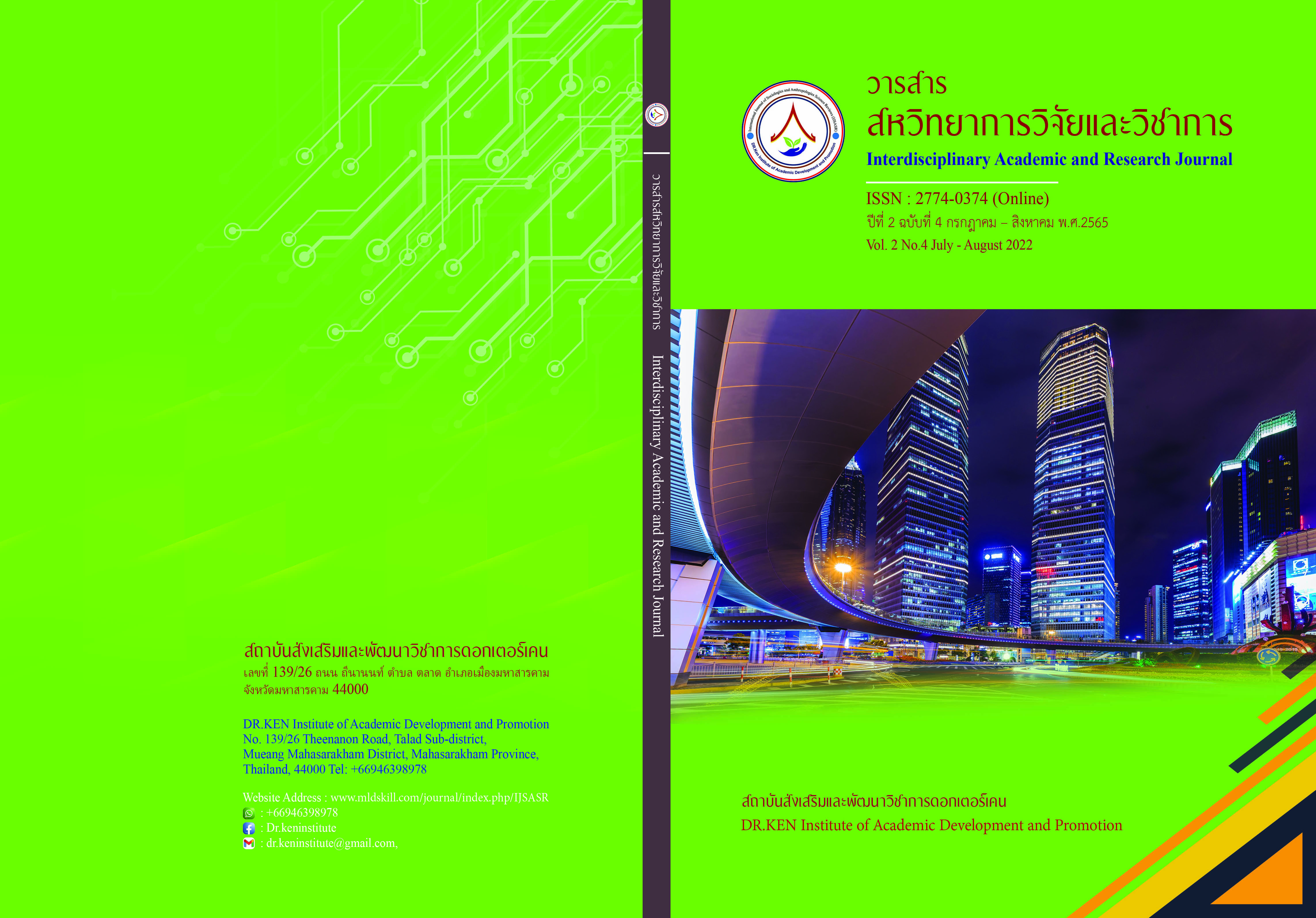นวัตกรรมบริการที่ส่งผลต่อความสำเร็จของการใช้บริการสั่งอาหารออนไลน์ผ่าน แอปพลิเคชันในช่วงการระบาดของไวรัสโควิด-19
DOI:
https://doi.org/10.14456/iarj.2022.68คำสำคัญ:
นวัตกรรมบริการ;, ความสำเร็จของการใช้บริการ;, การสั่งอาหารออนไลน์ผ่าน แอปพลิเคชัน; , ช่วงการระบาดของไวรัสโควิด-19บทคัดย่อ
จากสถานการณ์การแพร่ระบาดไวรัสโควิด-19 ตั้งแต่เดือนมกราคม 2563 เป็นต้นมา ทำให้ประชาชนทั่วไปมีปัญหาในการเข้าไปใช้บริการร้านอาหาร จึงเกิดการให้บริการสั่งอาหารออนไลน์ผ่าน แอปพลิเคชันในช่วงที่มีการระบาดของไวรัสโควิด-19 ดังนั้นบทความวิจัยนี้จึงมีวัตถุประสงค์ (1) เพื่อศึกษาลักษณะทั่วไปของผู้ใช้บริการสั่งอาหารออนไลน์ผ่าน แอปพลิเคชัน ในช่วงการระบาดของไวรัสโควิด-19 (2) เพื่อศึกษานวัตกรรมบริการที่มีผลต่อความสำเร็จของการใช้บริการสั่งอาหารออนไลน์ผ่าน แอปพลิเคชัน ในช่วงการระบาดของไวรัสโควิด-19 (3) เพื่อวิเคราะห์ความสัมพันธ์ระหว่างนวัตกรรมบริการและความสำเร็จของการใช้บริการสั่งอาหารออนไลน์ผ่าน แอปพลิเคชัน ในช่วงการระบาดของไวรัสโควิด-19 และ (4) เพื่อวิเคราะห์สมการถดถอยพหุคูณแบบเป็นขั้นตอนของนวัตกรรมบริการที่มีผลต่อความสำเร็จของการใช้บริการสั่งอาหารออนไลน์ผ่าน แอปพลิเคชัน ในช่วงการระบาดของไวรัสโควิด-19 กลุ่มตัวอย่าง คือ ผู้ใช้บริการสั่งอาหารออนไลน์ผ่าน แอปพลิเคชัน ในช่วงการระบาดของไวรัสโควิด-19 จำนวน 400 ตัวอย่าง โดยการเก็บรวบรวมข้อมูลแบบเฉพาะเจาะจง เครื่องมือที่ใช้ในการเก็บรวบรวมข้อมูล คือ แบบสอบถาม สถิติที่ใช้ในการวิจัย คือ สถิติเชิงพรรณนา ได้แก่ ค่าเฉลี่ย และส่วนเบี่ยงเบนมาตรฐาน การหาความสัมพันธ์อย่างง่ายของเพียร์สัน และการสร้างสมการถดถอยเชิงเส้นแบบพหุคูณด้วยวิธี Stepwise ผลการศึกษาพบว่า ผู้ใช้บริการส่วนใหญ่เป็นเพศหญิง มีอายุในช่วงอายุ 18 –25 ปี ระดับการศึกษาปริญญาตรี ประกอบอาชีพพนักงานบริษัทเอกชน มีรายได้เฉลี่ยต่อเดือน 20,001–30,000 บาท และ นวัตกรรมบริการที่มีความสัมพันธ์กับความสำเร็จของการใช้บริการสั่งอาหารออนไลน์ผ่าน แอปพลิเคชัน ในช่วงการระบาดของไวรัสโควิด-19 อย่างมีนัยสำคัญทางสถิติ ได้แก่ ด้านแนวคิดการให้บริการ (β) =0.160 ด้านการปฏิสัมพันธ์กับลูกค้า (β) =0.062 ด้านกระบวนการส่งมอบบริการใหม่ (β) =0.227 และด้านเทคโนโลยีการให้บริการ (β) =0.165 ดังนั้นเจ้าของธุรกิจควรนำนวัตกรรมบริการมาใช้ในการให้บริการสั่งอาหารออนไลน์ผ่าน แอปพลิเคชัน เพื่อให้ลูกค้าเกิดความพึงพอใจต่อธุรกิจ แล้วกลับมาใช้บริการในครั้งต่อไป และทำให้ธุรกิจประสบความสำเร็จอย่างต่อเนื่องและยั่งยืนในอนาคต
References
Adams, R., Bessant, J., & Phelps, R. (2020). Innovation management measurement: A review. International Journal of Management Reviews, 8 (1),21–47. DOI: 10.1111/j.1468-2370.2006.00119.x
Bhaskara, G.I. and Filimonau, V., 2021. The COVID-19 pandemic and organizational learning for disaster planning and management: A perspective of tourism businesses from a destination prone to consecutive disasters. Journal of Hospitality and Tourism Management, 46 (3), 364 - 375. DOI: 10.1016/j.jhtm.2021.01.011
Brewer, P., & Sebby, A. G. (2021). The effect of online restaurant menus on Consumers’purchase intentions during the COVID-19 pandemic. International Journal of Hospitality Management, 94, 102777.
Burnett, M., Johnston, A. (2020). Brexit anticipated economic shock on Ireland's planning for hospitality and tourism: resilience, volatility and exposure. Tourism Review. 75 (1). doi: https://doi.org/10.1108/TR-04-2019-0118.
Cheng. Y.-Y., Chen, C.-T. (2021). Construction of a service quality scale for the online food delivery industry. International Journal of Hospitality Management. 95 (4),102938. DOI: 10.1016/j.ijhm.2021.102938
Choosri, A. (2020). The Service Innovation, Corporate Social Responsibility, and Word-of-Mouth Marketing Affection Decision to Use the Private Hospital’s Inpatient Ward (IPD) in Bangkok. Independence Study of Business. Administration, Bangkok: Bangkok University.
Corpuz, J. C. G. (2021). Adapting to the culture of ‘new normal’: An emerging response to COVID-19. Journal of Public Health. 43 (2), 344–345, Doi: https://doi.org/10.1093/pubmed/fdab057
Dedeoglu, B. B., & Bogan, E. (2021). The motivations of visiting upscale restaurants during the COVID-19 pandemic: The role of risk perception and trust in government. International Journal of Hospitality Management, 95, 102905. Doi: https://doi.org/10.1016/j.ijhm.2021.102905
Den Hertog, P. (2010). Knowledge-intensive business services as co-producers of innovation. International Journal of Innovation Management. 4 (4), 491-528.
Gronroos, C. (2020). Service management and marketing: A customer relationship management approach. 2nd edition, UK: John Wiley & Sons.
Kautish, P., Paul, J., Sharma, R., (2021). The effect of assortment and fulfillment on shopping assistance and efficiency: An e-tail services cape perspective. J. Retail. Consum. Serv. 59 (3), 102393. Doi: https://doi.org/10.1016/j.jretconser.2020.102393
Marasco, A., De Martino, M., Magnotti, F., & Morvillo, A. (2018). Collaborative innovation in tourism and hospitality: A systematic review of the literature. International Journal of Contemporary Hospitality Management; Bradford. 30 (6), 2364-2395. DOI:10.1108/IJCHM-01-2018-0043
McKenzie-Mohr, D. (2000). Fostering sustainable behavior through community-based social marketing. American Psychologist. 55 (5), 531–537.
Ribeiro, G., & Cherobim, A. P. M. S. (2021). Environment and innovation: Discrepancy between theory and research practice. RAI Revista de Administração e Inovação. 14 (1), 30–40. Doi: https://doi.org/10.1016/j.rai.2016.10.002
The Bangkokpost. (2020). The food delivery challenge. [Online] April 10, 2022. Fromhttps://www.bangkokpost.com/business/1965615/delivery-platforms-dig-in-for-war.
Downloads
เผยแพร่แล้ว
How to Cite
ฉบับ
บท
License
Copyright (c) 2022 Busara Niyomves, Rungroje Songsraboon, Jitravee Thongtao, Sakulkarn Chaijariyavet, Patitta Opaspong

This work is licensed under a Creative Commons Attribution-NonCommercial-NoDerivatives 4.0 International License.
ลิขสิทธิ์ในบทความใดๆ ใน Interdisciplinary Academic and Research Journal ยังคงเป็นของผู้เขียนภายใต้ ภายใต้ Creative Commons Attribution-NonCommercial-NoDerivatives 4.0 International License การอนุญาตให้ใช้ข้อความ เนื้อหา รูปภาพ ฯลฯ ของสิ่งพิมพ์ ผู้ใช้ใดๆ เพื่ออ่าน ดาวน์โหลด คัดลอก แจกจ่าย พิมพ์ ค้นหา หรือลิงก์ไปยังบทความฉบับเต็ม รวบรวมข้อมูลเพื่อจัดทำดัชนี ส่งต่อเป็นข้อมูลไปยังซอฟต์แวร์ หรือใช้เพื่อวัตถุประสงค์ทางกฎหมายอื่นใด แต่ห้ามนำไปใช้ในเชิงพาณิชย์หรือด้วยเจตนาที่จะเป็นประโยชน์ต่อธุรกิจใดๆ














